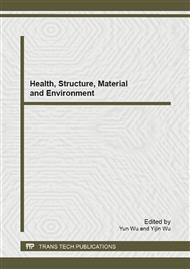[1]
M. Breysse, B. Claudel, L. Faure, M. Guein, R.J. J Williams, T. Wolkenstein, Chemiluminescence during the catalysis of carbon monoxide oxidation on a thoria surface, J. Catal. 45 (1976) 137-144.
DOI: 10.1016/0021-9517(76)90129-9
Google Scholar
[2]
M. Nakagawa, T. Okabayashi, T. Fujimoto, K. Utsunomiya, I. Yamamoto, T. Wada, Y. Yamashita, N. Yamashita, A new method for recognizing organic vapor by spectroscopic image on cataluminescence-based gas sensor, Sens. Actuators B 51 (1998) 159-162.
DOI: 10.1016/s0925-4005(98)00183-x
Google Scholar
[3]
T. Okabayashi, T. Fujimoto, I. Yamamoto, K. Utsunomiya, T. Wada, Y. Yamashita, N. Yamashita, M. Nakagawa, High sensitive hydrocarbon gas sensor utilizing cataluminescence of γ-Al2O3 activated with Dy3+, Sens. Actuators B 64 (2000) 54-58.
DOI: 10.1016/s0925-4005(99)00483-9
Google Scholar
[4]
M. Nakagawa, N. Yamashita, Cataluminescence-based gas sensors, Springer Ser. Chem. Sens. Biosens. 3 (2005) 93-132.
Google Scholar
[5]
K. W. Zhou, X. L. Ji, N. Zhang, X. R. Zhang, On-line monitoring of formaldehyde in air by cataluminescence-based gas sensor, Sens, Actuators B 119 (2009) 392-397.
DOI: 10.1016/j.snb.2005.12.038
Google Scholar
[6]
F. Wen, S. C. Zhang, N. Na, Y. Y. Wu, X. R. Zhang, Development of a sensitive gas sensor by trapping the analytes on nanomaterials and in situ cataluminescence detection, Sens. Actuators B 141 (2009) 168-173.
DOI: 10.1016/j.snb.2009.06.014
Google Scholar
[7]
R.K. Zhang, X. A. Cao, Y. H. Liu, Y. Peng, A highly sensitive and selective dimethyl ether sensor based on cataluminescence, Talanta 82 (2010) 728-732.
DOI: 10.1016/j.talanta.2010.05.039
Google Scholar
[8]
T. Okabayashia, M. Ozakib, M. Nakagawa, A new detection method of sevoflurane utilizing cataluminescence of γ- Al2O3 activated with Tb3+, Procedia Engineering 5 (2010) 1232-1235.
Google Scholar
[9]
R. K. Zhang, X. A. Cao, Y. H. Liu, X. Y. Chang, A new method for identifying compounds by luminescent response profiles on a cataluminescence based sensor, Anal. Chem. 83 (2011) 8975-8983.
DOI: 10.1021/ac201776b
Google Scholar
[10]
Y. Z. Jia, H. L. Zhang, L. Wu, Y. Lv, X. D. Hou, A new cataluminescence sensor for carbon tetrachloride using its catalytic reduction by hydrogen on palladium/carbon surface, Microchemical J. 95 (2010) 359-365.
DOI: 10.1016/j.microc.2010.02.013
Google Scholar
[11]
United States Environmental Protection Agency, The original list of hazardous air pollutants, http: /www. epa. gov/ttn/atw/188polls. html.
Google Scholar
[12]
International Agency for Research on Cancer, Agents Classified by the IARC Monographs, Volumes1–105, http: /monographs. iarc. fr/ENG/Classification/ClassificationsAlphaOrder. pdf.
Google Scholar
[13]
J. S. Lu, X. A. Cao, C. Y. Pan, L. F. Yang, G.B. Lai, J.L. Chen, C. Q. Wu, Studies of the cataluminescence of benzene homologues on nanosized γ–Al2O3/Eu2O3 and the development of a gas sensor for benzene homologue vapors, Sensors 6 (2006).
DOI: 10.3390/s6121827
Google Scholar
[14]
K. W. Zhou, Y. X. Zhao, Z. Xu, Y. Tong, Determination of BTX in air utilizing cataluminescence on nanometer composite materials, Chinese J. Anal. Lab. 25 (2006) 13-16.
Google Scholar
[15]
R. A. Mohammad; N. Na; F. Wen, S.C. Zhang, X. R. Zhang, Development of a plasma-assisted cataluminescence system for benzene, toluene, ethylbenzene, and xylenes Analysis, Anal. Chem. 82 (2010) 3457-3459.
DOI: 10.1021/ac1006975
Google Scholar
[16]
M. Liu, Research of γ-Al2O3/Pt catalyst for benzene hydrogenation in gas phase, J. Chem. Ind. Eng. 29 (2008) 7-10.
Google Scholar
[17]
Z.M. Liu, X. H. Li, Z. J. Chen, P. L. Ying, Z. C. Feng, C. Li, Effect of reduction method on the surface states of γ-Al2O3/Pt, J. Fuel Chem. Tech. 37 (2009) 205-211.
DOI: 10.1016/s1872-5813(09)60017-7
Google Scholar
[18]
Z. Q. Liu, J. Ma, Preparation and catalytic ozonation activity of Pt/CNTs catalyst, ACTA CHIM. SINICA 65 (2007) 2965-2970.
Google Scholar


